- Home
- East Yorkshire
- Bempton Cliffs
RSPB Bempton Cliffs - Seabird City
We’d been told by fellow birdwatchers that Bempton Cliffs, near Flamborough Head on the East Yorkshire coast, was the place to see puffins and gannets.
"It’s one the greatest wildlife spectacles in the country", they said.
So we booked a long weekend in Bridlington, full of high expectations
We visited in June, which is peak season for seabird activity.
The best time to see puffins is from mid-April to late July, with June offering the highest chance of spotting them as they busily tend their nests and bring in fish for their chicks.
Dogs are welcome too, as long as they’re on a short lead — we saw quite a few wagging tails along the trail. It’s a lovely place to walk together, with plenty of space to explore (or sniff every blade of grass, if you're a spaniel).
And as excited as I was to see the puffins, I couldn’t ignore the feeling in my stomach... cliff edges and I are not the best of friends.
I’ve had balance issues for years, and in the week before the trip, I’d started imagining myself toppling over into the cold North Sea.
First impressions
Thankfully, when we arrived and showed our RSPB membership cards at the visitor centre, I could breathe again.
The paths were well fenced, and six viewing platforms overhang the cliffs, offering absolutely breathtaking views — all without ever feeling unsafe.
Each platform had a designated space for wheelchair users thoughtfully positioned so everyone could enjoy the spectacle. And often, a friendly ranger was nearby with a telescope, happy to help us find the birds.
You’d think a puffin would be easy to spot with its bright beak and feet — but they’re surprisingly well-camouflaged among the light and shadow of the rocks. Having that extra help made all the difference.
(I know I’m getting ahead of myself, but those platforms left such an impression — they truly made the cliffs feel welcoming to everyone.)
And soon, I was focused on something far more important than my fears:
🪶 Half a million seabirds filling the cliffs with life.
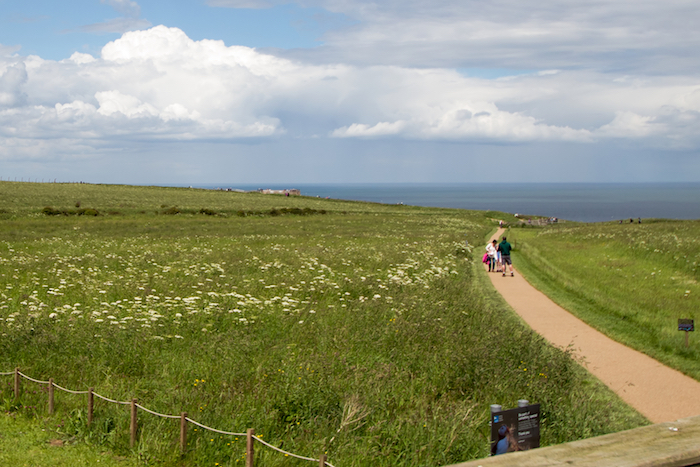 The path from the visitor centre gently winds through wildflower meadows toward the sea cliffs beyond.
The path from the visitor centre gently winds through wildflower meadows toward the sea cliffs beyond.The wrong equipment
It didn’t take long for the sights and sounds to sweep me up.
I barely thought about the cliffs after that. I was too busy switching lenses and chasing focus.
What I had brought:
- My trusty Canon 7D Mark II
- A 150-600mm Tamron lens
- A 70-200mm f/2.8
- A 24-105mm for landscapes
- Tripod + 2x extender
It was far from ideal. But it got me started.
When we came back the following year, I was better prepared.
Puffins
The Atlantic Puffin was the real draw for me. But where were they?
“There’s a Sea Parrot” exclaimed a man nearby.
He was pointing to the side of the cliff, so I focused my lens on it, using it as a telescope.
My first puffin.
They were there all along — I just needed to look a little closer.”
Some call them Clowns of the Sea – bright orange feet, comical waddles, and those rainbow-coloured bills.
Even with my longest lens, it was too far for a crisp shot. And truth be told, that lens wasn’t the sharpest anyway.
So the next day I switched to my 70-200mm f/2.8 with the 2x extender.
On the Canon 7D Mark II, it still allowed autofocus – and it was much sharper.
The results? Not perfect. But better. And the joy of simply watching them?
Unmatched.
If you’re not taking photos, a pair of binoculars is a must. The birds are often further away than you’d expect, and puffins especially can be surprisingly tricky to spot among the rocks.
You don’t need anything fancy. A small, lightweight pair (like 8x32s) is perfect for walks like this. And if you forget yours, the visitor centre sometimes has binoculars available to hire — just ask at the desk when you arrive.
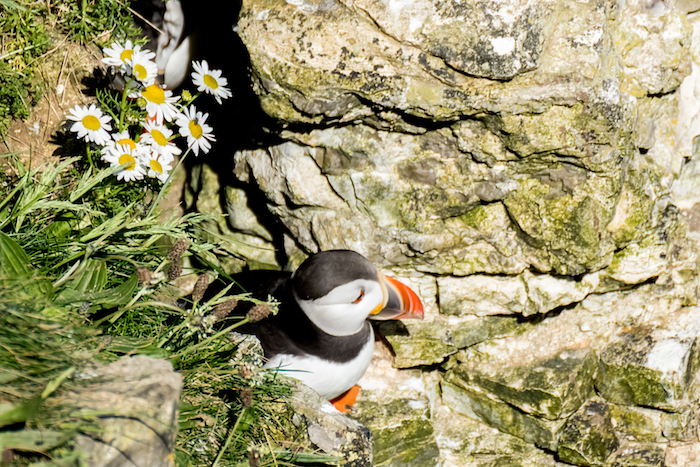 A puffin emerges into the morning light, framed by daisies and rugged cliff rock
A puffin emerges into the morning light, framed by daisies and rugged cliff rock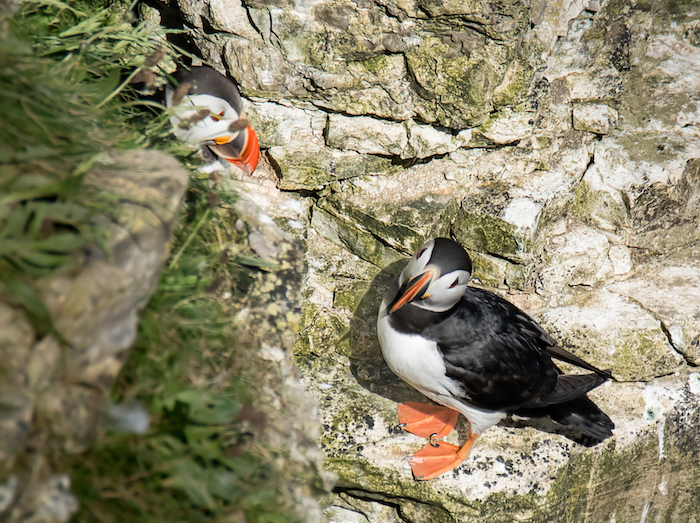 One puffin stands watch while another tucks in behind a ledge — bright feet and curious glances on the chalky cliffs of Bempton.
One puffin stands watch while another tucks in behind a ledge — bright feet and curious glances on the chalky cliffs of Bempton.Harsh Light, Happy Heart
As you can see in the first day’s photos — harsh shadows were a challenge.
Only a photographer could find a sunny day disappointing, eh?
But at least my husband didn’t mind walking for hours in the warmth.
The next day brought wind and rain.
When we showed our cards, the staff member laughed:
“Only RSPB members are daft enough to visit in this weather!”
If the weather had been truly awful, we could have just stayed warm in the visitor centre — they have live web cams streaming from the cliffs, so you can still watch the seabird drama unfold without stepping outside.
I’ll admit, I was tempted. A hot drink and a comfy seat while still seeing puffins? Very appealing on a day like that. But in the end, soggy or not, we headed out.
Northern Gannets
By far the largest seabird at Bempton Cliffs is the Northern Gannet - striking in white with black wing tips and pale golden heads.
They glided past us effortlessly before dropping down to greet their partners on the nests.
Some carried seaweed gifts. Other touched beaks in what looked like gentle celebration.
This is England's largest mainland gannet colony.
I was completly enchanted. And took hundreds of photos!
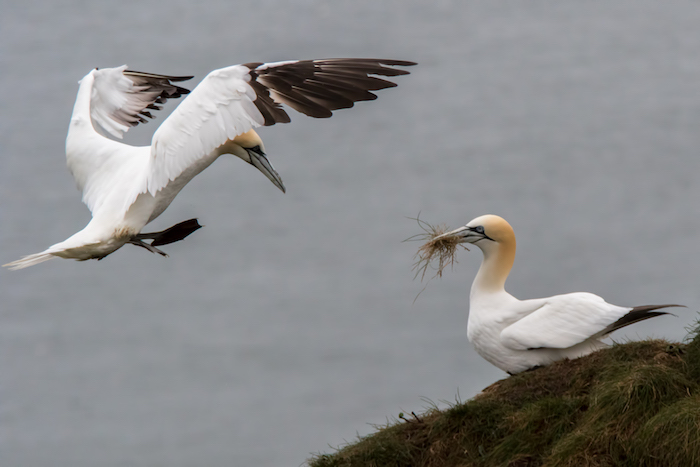 One gannet waits on the cliff with a bundle of nesting material, as its mate swoops in to join it — a quiet moment of teamwork during the breeding season.
One gannet waits on the cliff with a bundle of nesting material, as its mate swoops in to join it — a quiet moment of teamwork during the breeding season.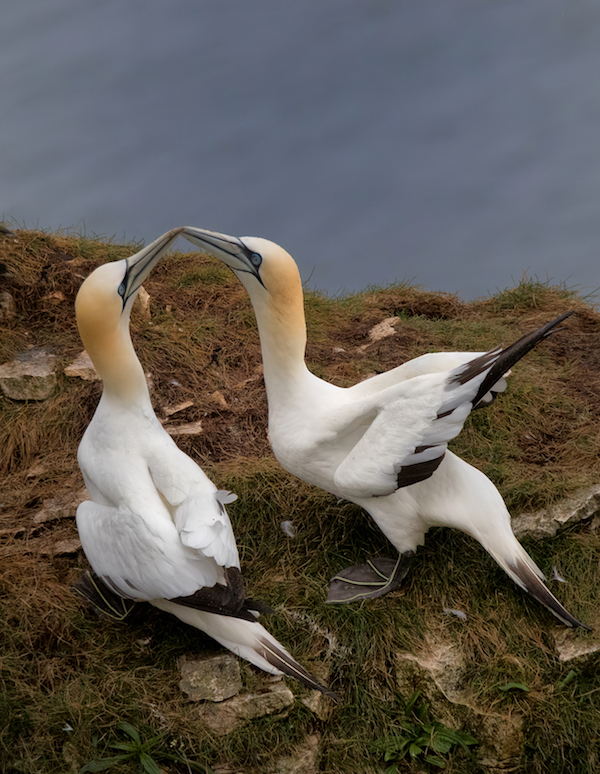 A pair of gannets greet each other on the cliff edge, raising their heads and gently tapping beaks — a graceful ritual of reunion.
A pair of gannets greet each other on the cliff edge, raising their heads and gently tapping beaks — a graceful ritual of reunion.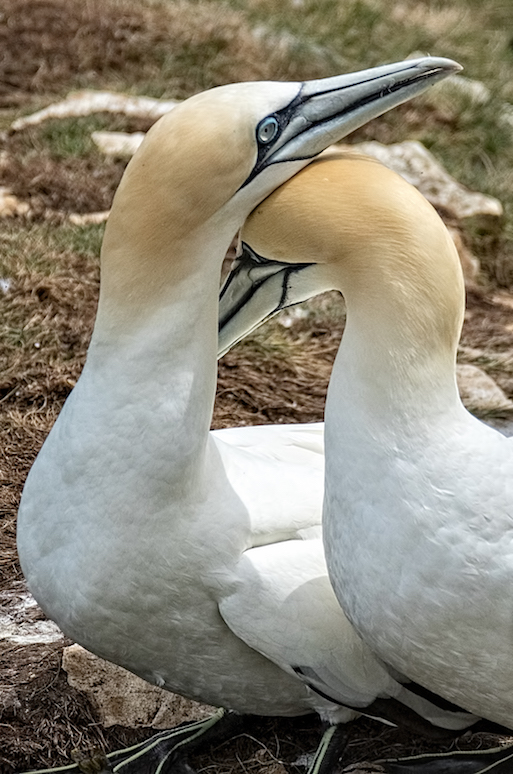 Up close, the gannets’ courtship becomes even more touching — gentle nuzzles, sky-blue eyes, and feathers brushed by trust
Up close, the gannets’ courtship becomes even more touching — gentle nuzzles, sky-blue eyes, and feathers brushed by trustSo many senses
You don’t quite expect the sound of it — thousands of birds squabbling, calling, flapping.
And the smell? Let’s just say not having a sense of smell is a bit of a superpower at Bempton!
Still, the sights were worth every second. And some of the details surprised me:
- Green stripes on their feet.
- Sky-blue rings around their eyes.
I would have loved to take some diving shot, but we didn’t manage a boat trip this time.
 Hundreds of gannets crowd the narrow cliff ledges, each pair claiming their patch of rock in the great seasonal gathering.
Hundreds of gannets crowd the narrow cliff ledges, each pair claiming their patch of rock in the great seasonal gathering.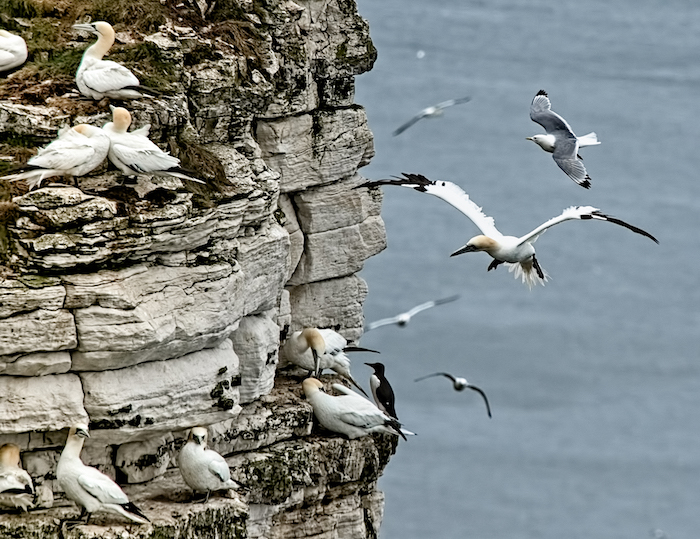 The cliff becomes a stage as gannets land, launch, and call — a swirling ballet of wings against the sea.
The cliff becomes a stage as gannets land, launch, and call — a swirling ballet of wings against the sea.Guillemots and razorbills
Tucked among the cliffs were razorbills and guillemots — smartly dressed in black and white.
They look quite similar at first glance, but there are clues:
- Razorbills have thick, blunt beaks with a white line across the tip
- Guillemots have slimmer, more pointed beaks — and their feathers are really dark brown, not black
Both are members of the auk family, along with the puffin.
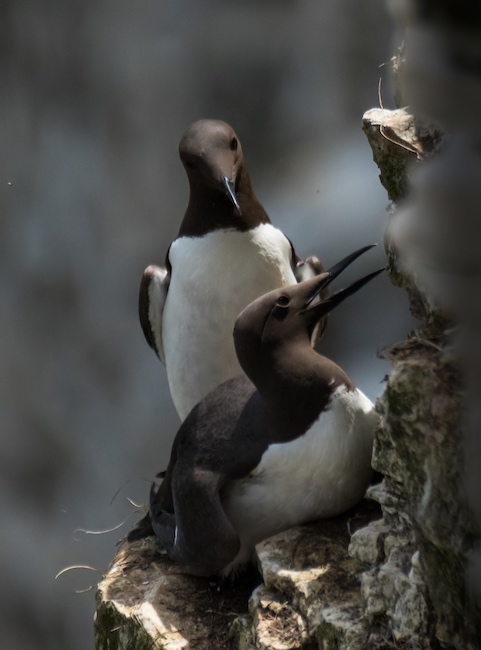 Perched on the tiniest ledge, the guillemots shift and shuffle — no nest, just balance, and trust in the stone beneath them.
Perched on the tiniest ledge, the guillemots shift and shuffle — no nest, just balance, and trust in the stone beneath them.They pack in tightly along narrow cliff ledges.
Instead of nests, they lay a single egg directly on the rock. The egg is pointed at one end — said to roll in a tight circle rather than off the edge.
The razorbills made me smile.
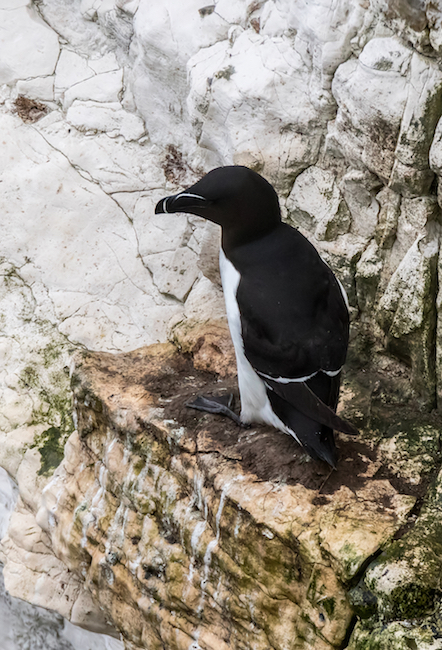 A razorbill stands on a sunlit ledge — all curve and contrast, carved perfectly for the cliffs it calls home.
A razorbill stands on a sunlit ledge — all curve and contrast, carved perfectly for the cliffs it calls home.They reminded me of penguins — stocky, flat-headed, with white bellies and black backs.
And when they lay down, their tails point up making them look like a banana!
Their chicks, not even three weeks old, leap from the cliffs to the sea — sometimes bouncing off rocks on the way.
A risky start, but they’re built for it.
The Kittiwake
Among all the seabird noise, one sound stood out — the distinctive "kitti-wake!" cry.
These medium-sized gulls have yellow beaks, white heads, grey wings, and a tail dipped in black.
They were the only birds we saw on eggs.
They’re on the red list now, sadly, due to falling numbers.
Kittiwakes nest here between February and August. For the rest of the year, they’re out at sea.
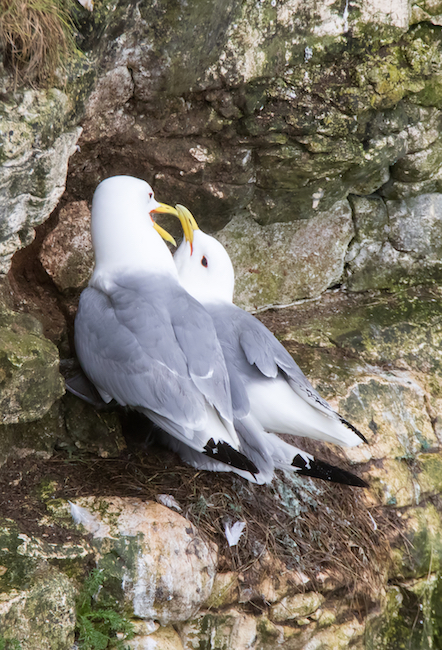 Kittiwakes share a gentle moment on the nest — soft voices, yellow bills, and the intimacy of cliffside life.
Kittiwakes share a gentle moment on the nest — soft voices, yellow bills, and the intimacy of cliffside life.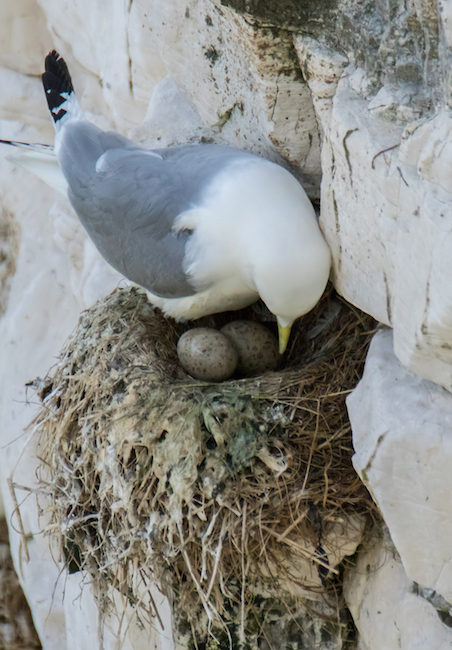 Balanced high above the sea, a kittiwake checks her precious clutch — the future held in two small, speckled shells.
Balanced high above the sea, a kittiwake checks her precious clutch — the future held in two small, speckled shells.Was it a gull?
We saw a few birds that looked like gulls — white heads, grey wings, yellow beaks.
But then we noticed the odd little tube on top of the beak. A Fulmar!
Don’t get too close... they’re known to spit. And it smells awful!
 With stiff-winged flight and a curious nose, the fulmar rides the sea breeze — graceful from a distance, quirky up close.
With stiff-winged flight and a curious nose, the fulmar rides the sea breeze — graceful from a distance, quirky up close.Smaller Birds at RSPB Bempton Cliffs
Bempton isn’t just about the cliffs.
Near the visitor centre, we spotted Tree Sparrows — with chestnut caps and cheek spots.
A male Linnet perched quietly along the hedgerow.
And then... a streak of green zipped past us.
A last-minute surprise sighting
I took two quick shots.
Later, over coffee, we zoomed in — and there it was:
A Parakeet!
Most likely an escapee, like the budgie someone had rescued the week before.
We loved our visit so much, we returned the following year.
You can read about that visit here.
Thanks for coming along with me.
If you ever get the chance — do go. It’s wild, and loud, and wonderful.
And maybe, just maybe…
A puffin will look back at you.

About the Author
Carol is a UK-based wildlife photographer and nature writer with a passion for peaceful walks, patient observation, and capturing life’s quiet wonders.
Through her lens and words, she shares the stories of the natural world — from bluebells and butterflies to birds like the great crested grebe.
Get closer to UK nature
Subscribe to Wild Lens!
Want to discover more hidden walks and wildlife moments?
I’d love to share my latest nature finds, photo tips, and peaceful walk recommendations with you.
💌 Join my newsletter Wild Lens—it’s free, occasional, and always rooted in a love of the natural world.
Subscribe below and come exploring with me.


